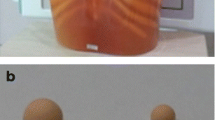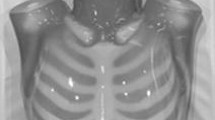Abstract
Purpose
To evaluate the feasibility of the iterative reconstruction (IR) method with low-dose multi-detector computed tomography (MDCT) for lung cancer screening.
Materials and methods
A chest CT phantom containing simulated ground-glass nodules (GGNs) of 5 different sizes was scanned by use of 16-row and 64-row MDCT. Tube currents of 10, 20, and 30 mA were used for the low-dose CT. To assess the detectability of pure GGNs, a radiologist-performance test was conducted. Mean visual scores for simulated GGNs were compared for reconstructed images from filtered back-projection (FBP) and the IR method.
Results
When 64-row MDCT was used, visual scores for simulated GGNs were significantly higher for the IR method than for the FBP method under any conditions; scores were also significantly higher for 16-row MDCT under some conditions.
Conclusions
The results of this experimental chest phantom study showed that use of the IR method improved the detectability of simulated pure GGNs.





Similar content being viewed by others
References
Aberle DR, Adams AM, Berg CD, Black WC, Clapp JD, Fagerstrom RM, et al. Reduces lung-cancer mortality with low-dose computed tomographic screening. N Engl J Med. 2011;365:395–409.
Riley K. FDA Makes Interim recommendations to address concern of excess radiation exposure during CT perfusion imaging [U.S. Food and Drug Administration Web site]. Dec 7, 2009. Available at: http://www.fda.gov/NewsEvents/Newsroom/PressAnnouncements/ucm193190.htm. Accessed 1 July 2013.
Imanishi Y, Fukui A, Niimi H, Itho D, Nozaki K, Nakaji S, et al. Radiation-induced temporary hair loss as a radiation damage only occurring in patients who had the combination of MDCT and DSA. Eur Radiol. 2005;15:41–6.
Yamada Y, Jinzaki M, Hosokawa T, Tanami Y, Sugiura H, Abe T, et al. Dose reduction in chest CT: comparison of the adaptive iterative dose reduction 3D, adaptive iterative dose reduction, and filtered back projection reconstruction techniques. Eur J Radiol. 2012;81:4185–95.
Tomizawa N, Nojo T, Akahane M, Torigoe R, Kiryu S, Ohtomo K. Adaptive iterative dose reduction in coronary CT angiography using 320-row CT: assessment of radiation dose reduction and image quality. J Cardiovasc Comput Tomogr. 2012;6:318–24.
Juri H, Matsuki M, Itou Y, Inada Y, Nakai G, Azuma H, et al. Initial experience with adaptive iterative dose reduction 3D to reduce radiation dose in computed tomographic urography. J Comput Assist Tomogr. 2013;37:52–7.
Yu L, Liu X, Leng S, Kofler JM, Ramirez-Giraldo JC, Qu M, et al. Radiation dose reduction in computed tomography: techniques and future perspective. Imaging Med. 2009;1:65–84.
Funama Y, Awai K, Liu D, Oda S, Yanaga Y, Nakaura T, et al. Detection of nodules showing Ground-Glass Opacity in the lungs at low-dose multidetector computed tomography: phantom and clinical study. J Comput Assist Tomogr. 2009;33:49–53.
Muramatsu Y, Tsuda Y, Nakamura Y, Kubo M, Tayama T, Hanai K. The development and use of a chest phantom for optimizing scanning techniques on a variety of low-dose helical computed tomography devices. J Comput Assist Tomogr. 2003;27:364–74.
Matsumoto K, Ohno Y, Koyama H, Kono A, Inokawa H, Onishi Y, et al. 3D automatic exposure control for 64-detector row CT: radiation dose reduction in chest phantom study. Eur J Radiol. 2011;77:522–7.
Kubo T, Ohno Y, Gautam S, Lin PP, Kauczor H, Hatabu H. Use of 3D adaptive raw-data filter in CT of the lung: effect on radiation dose reduction. AJR. 2008;191:W167–74.
Bach PB, Mirkin JN, Oliver TK, Azzoli CG, Berry DA, Brawley OW, et al. Benefits and harms of CT screening for lung cancer. JAMA. 2012;307:2418–29.
González AB, Darby S. Risk of cancer from diagnostic X-rays: estimates for the UK and 14 other countries. Lancet. 2004;363:345–51.
Pearce MS, Salotti JA, Little MP, McHugh K, Lee C, Kim KP, et al. Radiation exposure from CT scans in childhood and subsequent risk of leukemia and brain tumours: a retrospective cohort study. Lancet. 2012;380:499–505.
Nakata M, Saeki H, Takata I, Segawa Y, Mogami H, Mandai K, et al. Focal ground-glass opacity detected by low-dose helical CT. Chest. 2002;121:1464–7.
Swenson SJ, Jett JR, Sloan JA, Midthun DE, Hartman TE, Sykes A, et al. Screening for lung cancer with low-dose spiral computed tomography. Am J Respir Crit Care Med. 2002;165:508–13.
Li F, Sone S, Abe H, Macmahon H, Armato G II, Doi K. Lung cancers missed at low – dose helical CT screening in a general population: comparison of clinical, histopathologic, and imaging findings. Radiology. 2002;225:673–83.
Jaklitsch MT, Jacobson FL, Austin JHM, Field JK, Jett JR, Keshavjee S, et al. The American Association for Thoracic Surgery guidelines for lung cancer screening using low-dose computed tomography scans for lung cancer survivors and other high-risk groups. J Thorac Cardiovasc Surg. 2012;144:33–8.
Acknowledgments
The authors would like to thank F. Suzuki, MD, T. Hara, MD, N. Niiya, MD, H. Fujisawa, MD, J. Watari, MD, and T. Ikegmi, MD for their participation in our radiologist-performance test, T. Iinuma, MD, for advice about our study, and M. Taguri, Ph.D. and M. Saito, for statistical analysis. This research was not supported by any external funding.
Conflict of interest
The authors declare that they have no conflicts of interest.
Author information
Authors and Affiliations
Corresponding author
About this article
Cite this article
Akashita, S., Tachibana, Y., Sakamaki, K. et al. Detection of pure ground-glass nodules in the lung by low-dose multi-detector computed tomography, with use of an iterative reconstruction method: a comparison with conventional image reconstruction by the filtered back-projection method. Jpn J Radiol 33, 113–121 (2015). https://doi.org/10.1007/s11604-014-0384-z
Received:
Accepted:
Published:
Issue Date:
DOI: https://doi.org/10.1007/s11604-014-0384-z




